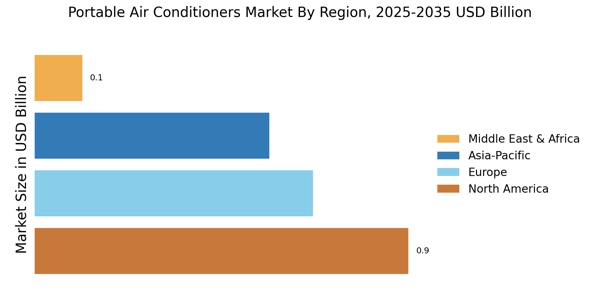Flexibility and Portability
The Portable Air Conditioners Market benefits significantly from the inherent flexibility and portability of these units. Unlike traditional air conditioning systems, portable air conditioners can be easily moved from one room to another, catering to the diverse needs of consumers. This adaptability is particularly appealing to renters and those living in smaller spaces where installation of permanent units may not be feasible. The market data indicates that the sales of portable air conditioners have increased by approximately 15% over the past year, reflecting a growing preference for versatile cooling solutions. Additionally, the ability to use these units in various settings, such as homes, offices, and temporary spaces, enhances their appeal, thereby driving market growth.
Seasonal Demand Fluctuations
The Portable Air Conditioners Market experiences notable seasonal demand fluctuations, particularly during warmer months. As temperatures rise, consumers increasingly seek effective cooling solutions, leading to a spike in sales of portable air conditioners. This seasonal trend is supported by market data, which shows that sales typically peak between May and August, aligning with the hottest months of the year. Retailers often capitalize on this trend by offering promotions and discounts, further stimulating demand. Additionally, the growing trend of outdoor living spaces has led to an increased interest in portable air conditioners, as consumers look for ways to enhance comfort in patios and outdoor areas during the summer months.
Growing Awareness of Indoor Air Quality
The Portable Air Conditioners Market is witnessing a surge in demand driven by increasing awareness regarding indoor air quality. Consumers are becoming more cognizant of the health implications associated with poor air quality, which can lead to respiratory issues and other health problems. As a result, portable air conditioners, which often come equipped with air purification features, are gaining traction. The market is projected to grow as individuals seek solutions that not only cool their spaces but also enhance air quality. This trend is particularly pronounced in urban areas where pollution levels are higher, and the need for clean air is paramount. The integration of advanced filtration systems in portable air conditioners further supports this trend, making them a preferred choice for health-conscious consumers.
Rising Disposable Income and Consumer Spending
The Portable Air Conditioners Market is positively impacted by rising disposable income and increased consumer spending. As individuals have more financial resources at their disposal, they are more inclined to invest in home comfort solutions, including portable air conditioners. This trend is particularly evident in emerging markets, where economic growth is leading to a burgeoning middle class. Market data indicates that the demand for portable air conditioners has risen by approximately 20% in these regions, as consumers prioritize comfort and convenience in their living spaces. This increase in purchasing power is likely to sustain the growth trajectory of the portable air conditioners market, as more consumers seek to enhance their home environments.
Technological Advancements in Cooling Solutions
The Portable Air Conditioners Market is significantly influenced by ongoing technological advancements in cooling solutions. Innovations such as energy-efficient compressors, smart connectivity features, and enhanced cooling technologies are reshaping consumer preferences. These advancements not only improve the performance of portable air conditioners but also contribute to energy savings, which is a critical consideration for many consumers. Market data suggests that units with smart technology integration are witnessing higher sales, as they offer convenience and control through mobile applications. This trend indicates a shift towards more sophisticated and user-friendly cooling solutions, which is likely to drive further growth in the portable air conditioners market.


















Leave a Comment